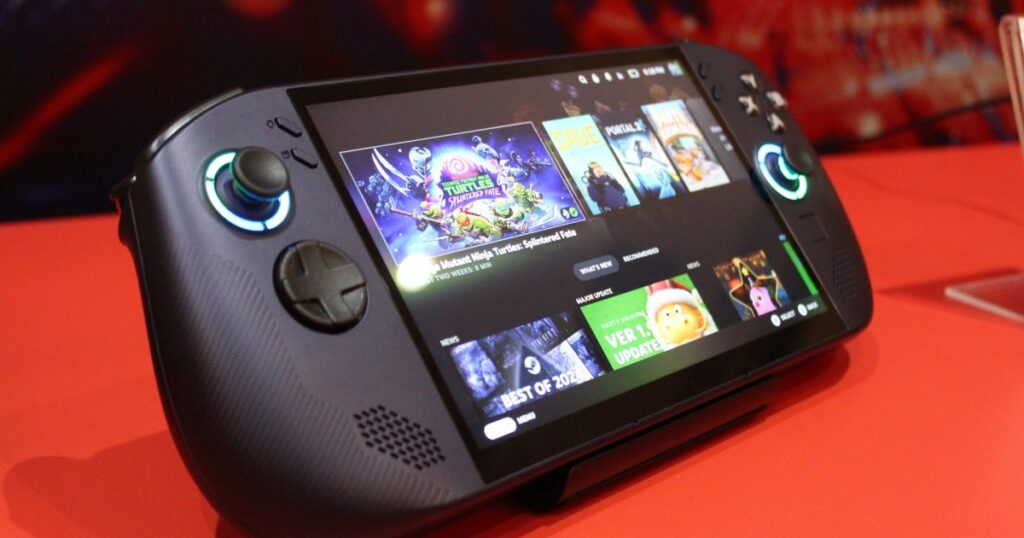Lenovo’s Legion Go 2 was just one of the worst-kept keys for CES 2025, and now we do not need to pretend anymore, as we have actually not only seen it real, however we’ve had some hands-on time with it also, and we’re really thrilled. With an updated display screen, processor, and recently affordable cost, the Legion Go S is gunning for the Steam Deck’s crown. Most notably, it’ll likely be the very first dedicated SteamOS portable offered outside of the Heavy steam Deck– although SteamOS will certainly be extra widely readily available as a whole also.
We won’t understand specifically just how great the Legion Go S is until we can have some more time to examination and criteria it, however we have a concept about what it can, and great deals of exciting brand-new details to ponder. Below’s how the Lenovo Myriad Go S and Heavy steam Deck OLED contrast.
Expense is king
Although rates is very important for just about every technical item, mobile gaming systems are specifically impacted by it. They’re made as a much more budget friendly, a lot more portable pc gaming service for on-the-go play than laptops and desktops, offering a console-like experience for very easy gaming wherever you are. Flagship tools like the ROG Ally X and first-generation Myriad Go could thrill, but they was available in a lot more pricey than the Vapor Deck when they debuted. That’s not the situation with the Myriad Go S.
The entry-level design starts at $ 500, which features the AMD Ryzen Z 2 Go chip and runs SteamOS. That price damages the Vapor Deck OLED by $ 50 It’s still much more costly than the older LCD model, of course. On the other hand, there will also be an extra effective Z 1 Severe (and eventually a Z 2 Severe) arrangement, but we don’t yet recognize the specific price on it.
There’s additionally the Windows 11 configurations to think about. The firstly the Legion Go S designs that will certainly be readily available will certainly be the least attractive offering, the premium $ 730 Z 1 Extreme version, running Windows 11 In May, there will certainly be an entry-level offering with the very same specifications as the SteamOS model, however it will set you back $ 30 additional at $ 530
The last crease to think about is that, reportedly, there is no Z 2 -based Steam Deck 2 presently in the jobs to compete with the extra efficiency in the Myriad Go S.
Specification comparison
Spec tables never ever inform the whole story, but they’re a good way to begin one. We have a complete specification sheet for the Legion Go S, from its CPU to its battery dimension, weight, and port setup. Below’s exactly how it compares to the Heavy Steam Deck OLED.
| Heavy Steam Deck OLED | Lenovo Myriad Go S | |
| APU | AMD personalized APU: 6 nm, 4 Zen 2 cores/ 8 strings, approximately 3 5 GHz | AMD Ryzen Z 2 Go: 4 Zen 3 cores/ 8 threads, as much as 4 3 GHz
AMD Ryzen Z 1 Extreme: 8 Zen 4 cores/ 16 threads, up to 5 1 GHz |
| Memory | 16 GB LPDDR 5 – 6400 | 16 GB LPDDR 5 – 6400 32 GB LPDDR 5 X- 6400 |
| Storage space | 512 GB NVMe SSD 1 TB NVMe SSD |
512 GB NVMe SSD 1 TB NVMe SSD |
| Display | 7 4 -inch 1, 280 x 800 HDR OLED, 90 Hz | 8 -inch, 1920 x 1200 LCD, 120 Hz, 500 nits |
| Ports | 1 x USB-C, 1 x microSD slot, 1 x 3 5 mm audio | 2 x USB-C, 3 5 mm audio, microSD slot |
| Battery capacity | 50 Wh | 55 5 Wh |
| Dimensions (LxWxH) | 11 73 x 4 6 x 1 93 inches | 11 77 x 5 x 0. 89 inches |
| Weight | 1 40 extra pounds | 1 61 extra pounds |
| Price | $ 550/$ 650 | $ 500 + |
The Legion Go S it the more recent tool, so it’s not a surprise to see it come in with more remarkable requirements, however they are rather remarkable in a couple of circumstances. The CPU alternatives are perhaps the most stark, with the higher-end Z 1 severe looking specifically subdued contrasted to the older Zen 2 based CPU cores in the Steam Deck. The Z 2 Go matches the core varieties of the Steam Deck, while updating them to Zen 3, with an improved clock rate.
Importantly, though, it matters not whether you pick the Z 2 Go or the Z 1 Extreme, they each have the same 12 core RDNA 3 GPU onboard, so it should provide similar graphical efficiency, also if the Z 1 Extreme will be the extra qualified CPU.
The Myriad Go S features double the memory of the Steam Deck, which must open up support for even more requiring video games in the future, as well as make it a much more capable device for multitasking if you want to run history streaming applications, or similar.
The brand-new Legion Go display is bigger and brighter than the Vapor Deck’s, with a greater refresh rate. It’s LCD, however, so as long as it might look exceptional, even in brightly lit rooms, it won’t have the abundant depth of comparison and color of the Steam Deck’s OLED panel.
Weight wise, there isn’t much between the two tools, although the Legion Go S is significantly thinner, giving it a sleeker account.
Layout

The Legion Go S abandons the removable controls of the initial Myriad Go (which is being conserved for the Myriad Go 2 for an incorporated style that our very own Jacob Cockroach said makes it “significantly a lot more comfortable in the hands, with a smaller sized overall body that’s nevertheless loading an 8 -inch display.” However, he did say that it still isn’t as comfy as the Heavy steam Deck.
At the same time, note that the Myriad Go S is a little bit thinner than the Heavy steam Deck OLED, however it’s slightly much heavier.
The Legion Go S will feature your selection of Windows or SteamOS, relying on your preferences, and Jacob located the Windows version snappy and receptive in his brief hands-on. The bigger touchpad style on the Steam Deck is extra practical, however the mini touchpad on the Legion Go S is completely useful for fast swipes and even some accuracy control.
The Steam Deck’s OLED panel is richer and more vivid than the LCD on the Myriad Go S, however it looks very crisp at 1080 p and at 120 Hz and is buttery smooth at higher framework prices. There’s a disagreement to be made that that added clarity and responsiveness might give the Legion Go S a mild advantage in competitive games, but there won’t be a great deal in it when you factor in OLED’s faster pixel action time.
Efficiency
With the caveat that we don’t know just how fast the Myriad Go S with its new CPUs will be up until we check it, it will absolutely be faster than the Heavy steam Deck, and possibly fairly drastically so. Its CPU cores are more recent, more various most of the times, and much much faster. The GPU, too, is a more recent generation (RDNA 3 versus RDNA 2 and it has more calculate units (12 versus8 A lot of that added power will certainly be utilized to drive the greater resolution of the Legion Go S, but there must be enough left over to maintain frame prices greater too. With a 120 Hz display screen over the Heavy steam Deck’s 90 Hz, that might make all the difference.
We’ll leave this area a little barebones in the meantime until we see a lot more, however recognize that the Myriad Go S will certainly be much faster, while being valued really competitively.
Newer is typically better

The Vapor Deck could be nearing its three-year wedding anniversary, yet Shutoff has actually made it clear it’s not prepared to change it right now. With such an aging piece of hardware, it’s not a surprise to see newer choices from big names like Lenovo quickly supplying even more performance at a comparable rate. It also has a bigger, quicker, and brighter screen– also if it can’t fairly use the comparison and vibrant coloring of OLED.
Yet it’s still not rather as comfy, as our Jacob Roach explained, and its touchpad is significantly smaller. There are most likely to be a few other little niggles and eccentricities that keep the initial Steam Deck in the battle, even if it’s shedding on a lot of fronts.
The much newer Legion Go S is most likely to be the better choice once its full suite of alternatives is offered, however don’t count the Heavy steam Dress up just yet. All Valve would certainly require to do to maintain it pertinent is knock a little off the cost, and as newer, much faster chips and equipment becomes available, that seems much more workable every day.


